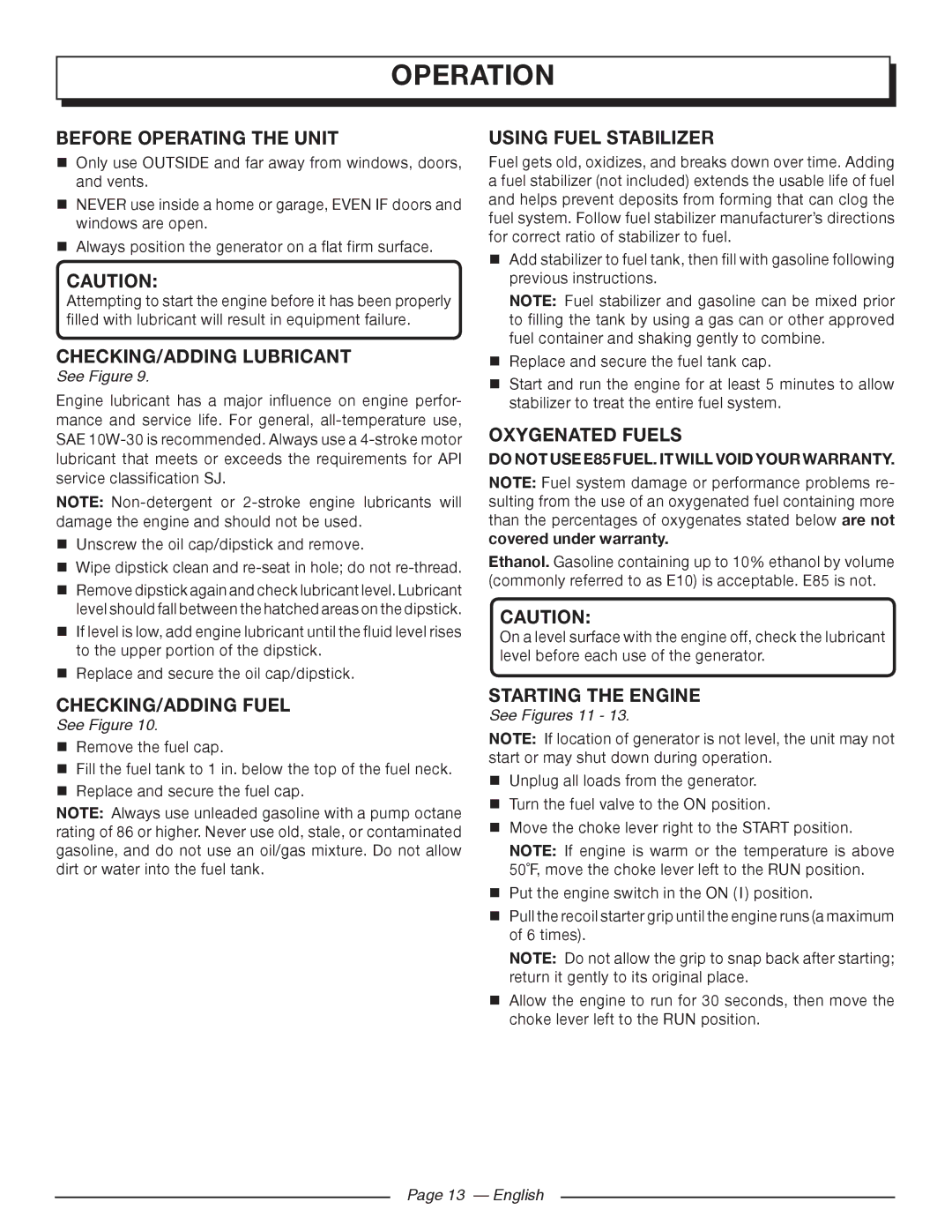
OPERATION
BEFORE OPERATING THE UNIT
Only use OUTSIDE and far away from windows, doors, and vents.
NEVER use inside a home or garage, EVEN IF doors and windows are open.
Always position the generator on a flat firm surface.
CAUTION:
Attempting to start the engine before it has been properly filled with lubricant will result in equipment failure.
CHECKING/ADDING LUBRICANT
See Figure 9.
Engine lubricant has a major influence on engine perfor- mance and service life. For general,
NOTE:
Unscrew the oil cap/dipstick and remove.
Wipe dipstick clean and
Remove dipstick again and check lubricant level. Lubricant level should fall between the hatched areas on the dipstick.
If level is low, add engine lubricant until the fluid level rises to the upper portion of the dipstick.
Replace and secure the oil cap/dipstick.
CHECKING/ADDING FUEL
See Figure 10.
Remove the fuel cap.
Fill the fuel tank to 1 in. below the top of the fuel neck.
Replace and secure the fuel cap.
NOTE: Always use unleaded gasoline with a pump octane rating of 86 or higher. Never use old, stale, or contaminated gasoline, and do not use an oil/gas mixture. Do not allow dirt or water into the fuel tank.
USING FUEL STABILIZER
Fuel gets old, oxidizes, and breaks down over time. Adding a fuel stabilizer (not included) extends the usable life of fuel and helps prevent deposits from forming that can clog the fuel system. Follow fuel stabilizer manufacturer’s directions for correct ratio of stabilizer to fuel.
Add stabilizer to fuel tank, then fill with gasoline following previous instructions.
NOTE: Fuel stabilizer and gasoline can be mixed prior to filling the tank by using a gas can or other approved fuel container and shaking gently to combine.
Replace and secure the fuel tank cap.
Start and run the engine for at least 5 minutes to allow stabilizer to treat the entire fuel system.
OXYGENATED FUELS
DO NOT USE E85 FUEL. IT WILL VOID YOUR WARRANTY.
NOTE: Fuel system damage or performance problems re- sulting from the use of an oxygenated fuel containing more than the percentages of oxygenates stated below are not covered under warranty.
Ethanol. Gasoline containing up to 10% ethanol by volume (commonly referred to as E10) is acceptable. E85 is not.
CAUTION:
On a level surface with the engine off, check the lubricant level before each use of the generator.
STARTING THE ENGINE
See Figures 11 - 13.
NOTE: If location of generator is not level, the unit may not start or may shut down during operation.
Unplug all loads from the generator.
Turn the fuel valve to the ON position.
Move the choke lever right to the START position.
NOTE: If engine is warm or the temperature is above
50˚F, move the choke lever left to the RUN position.
Put the engine switch in the ON ( I ) position.
Pull the recoil starter grip until the engine runs (a maximum of 6 times).
NOTE: Do not allow the grip to snap back after starting; return it gently to its original place.
Allow the engine to run for 30 seconds, then move the choke lever left to the RUN position.
Page 13 — English
